MGT6211 - Porter's Shared Value Theory: Ethics and Competitive Edge
VerifiedAdded on 2022/12/15
|14
|4024
|452
Essay
AI Summary
This essay critically examines Michael Porter's Shared Value theory within the context of Business Ethics and Corporate Social Responsibility (CSR). It begins by defining CSR and its historical evolution, then delves into Porter's model, highlighting its emphasis on the mutual benefits between corporations and society. The essay explores the linkage between CSR and competitive advantage, discussing how strategic CSR can enhance an organization's reputation and brand value. It also addresses the limitations of Porter's Value Chain Analysis (VCA) model, particularly its perceived lack of an ethical core and its potential to prioritize profit maximization over genuine societal needs. The essay concludes by underscoring the importance of integrating ethical considerations into business strategies to achieve both competitive advantage and meaningful social impact.
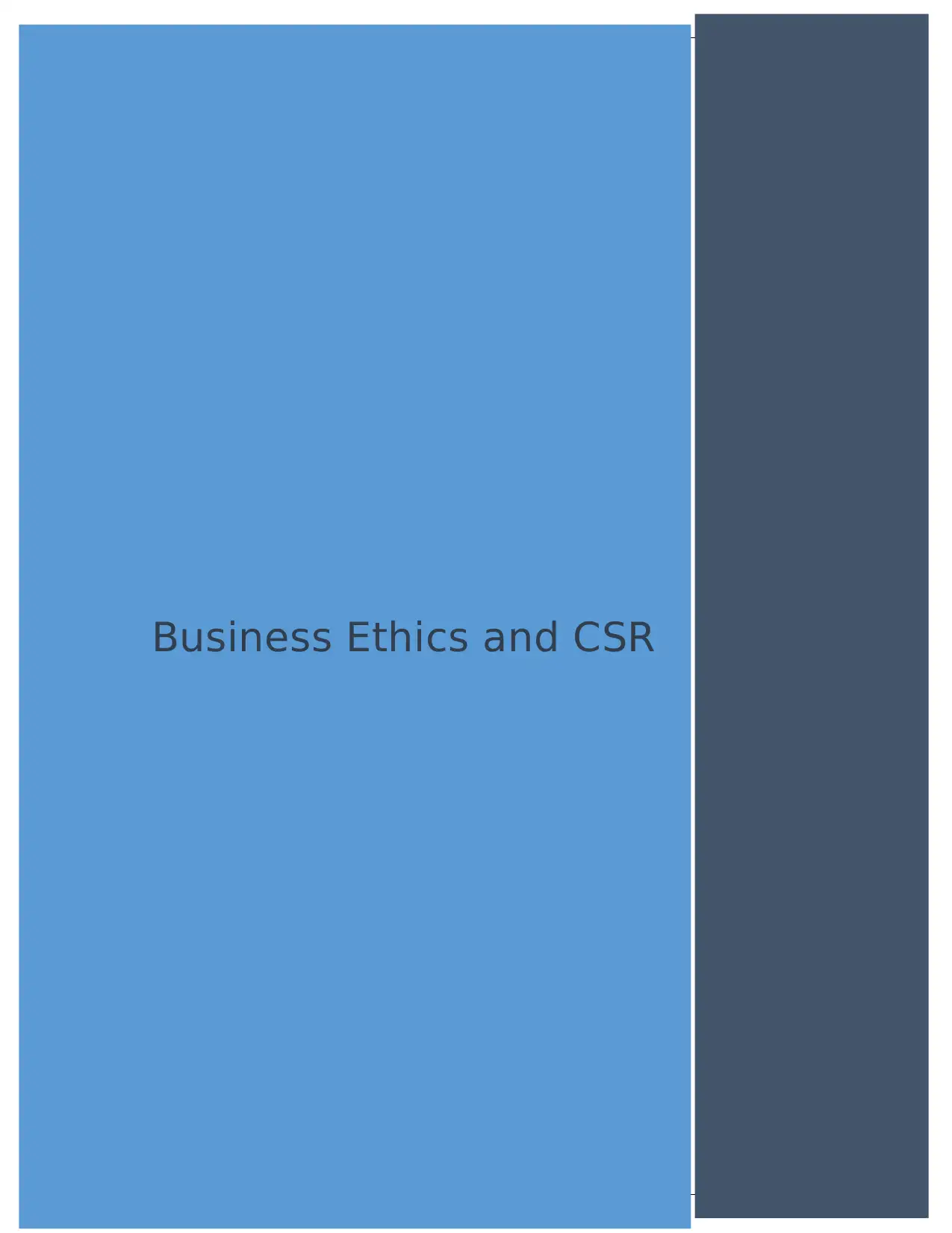
Business Ethics and CSR
Paraphrase This Document
Need a fresh take? Get an instant paraphrase of this document with our AI Paraphraser
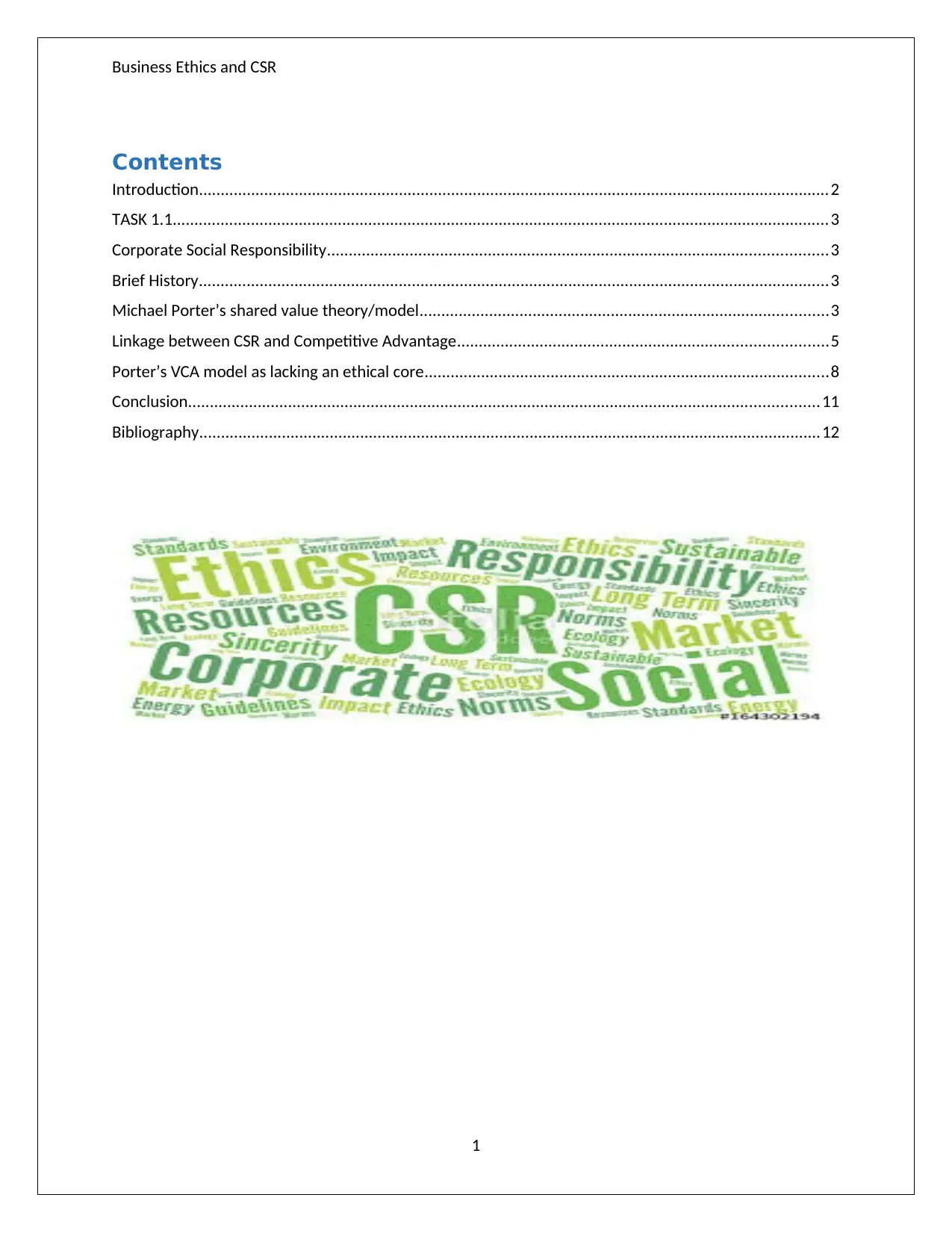
Business Ethics and CSR
Contents
Introduction.................................................................................................................................................2
TASK 1.1.......................................................................................................................................................3
Corporate Social Responsibility...................................................................................................................3
Brief History.................................................................................................................................................3
Michael Porter’s shared value theory/model..............................................................................................3
Linkage between CSR and Competitive Advantage.....................................................................................5
Porter’s VCA model as lacking an ethical core.............................................................................................8
Conclusion.................................................................................................................................................11
Bibliography...............................................................................................................................................12
1
Contents
Introduction.................................................................................................................................................2
TASK 1.1.......................................................................................................................................................3
Corporate Social Responsibility...................................................................................................................3
Brief History.................................................................................................................................................3
Michael Porter’s shared value theory/model..............................................................................................3
Linkage between CSR and Competitive Advantage.....................................................................................5
Porter’s VCA model as lacking an ethical core.............................................................................................8
Conclusion.................................................................................................................................................11
Bibliography...............................................................................................................................................12
1
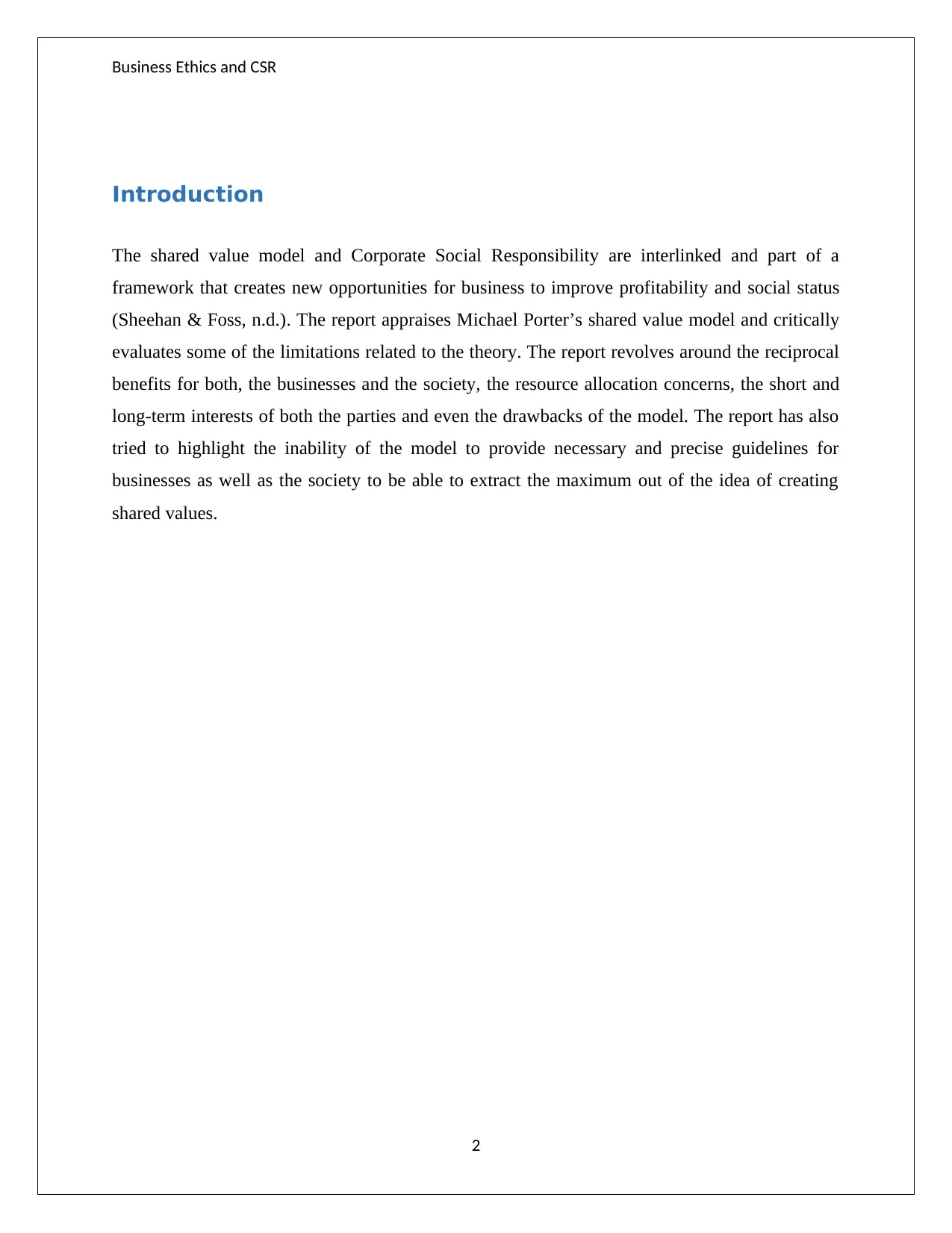
Business Ethics and CSR
Introduction
The shared value model and Corporate Social Responsibility are interlinked and part of a
framework that creates new opportunities for business to improve profitability and social status
(Sheehan & Foss, n.d.). The report appraises Michael Porter’s shared value model and critically
evaluates some of the limitations related to the theory. The report revolves around the reciprocal
benefits for both, the businesses and the society, the resource allocation concerns, the short and
long-term interests of both the parties and even the drawbacks of the model. The report has also
tried to highlight the inability of the model to provide necessary and precise guidelines for
businesses as well as the society to be able to extract the maximum out of the idea of creating
shared values.
2
Introduction
The shared value model and Corporate Social Responsibility are interlinked and part of a
framework that creates new opportunities for business to improve profitability and social status
(Sheehan & Foss, n.d.). The report appraises Michael Porter’s shared value model and critically
evaluates some of the limitations related to the theory. The report revolves around the reciprocal
benefits for both, the businesses and the society, the resource allocation concerns, the short and
long-term interests of both the parties and even the drawbacks of the model. The report has also
tried to highlight the inability of the model to provide necessary and precise guidelines for
businesses as well as the society to be able to extract the maximum out of the idea of creating
shared values.
2
⊘ This is a preview!⊘
Do you want full access?
Subscribe today to unlock all pages.

Trusted by 1+ million students worldwide
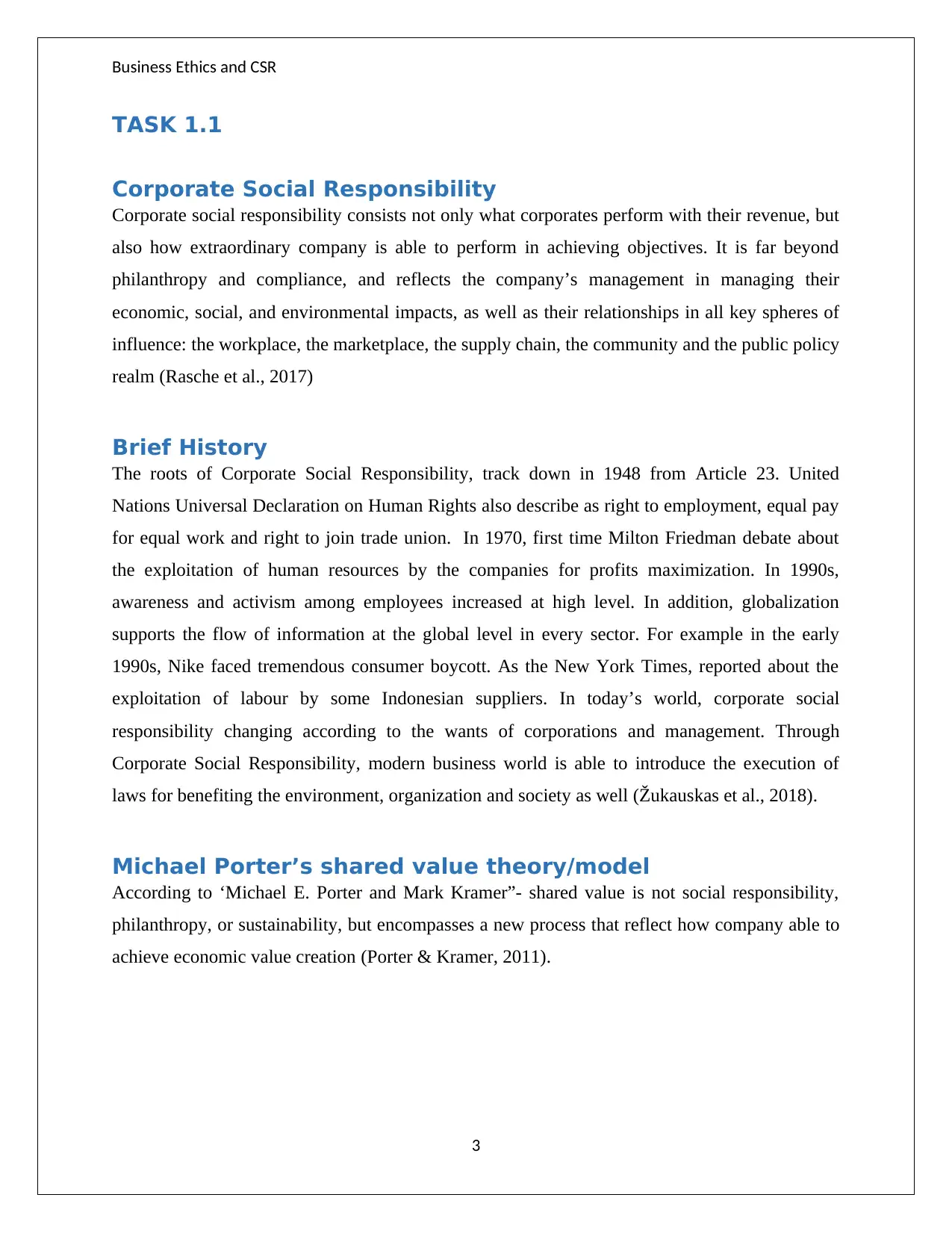
Business Ethics and CSR
TASK 1.1
Corporate Social Responsibility
Corporate social responsibility consists not only what corporates perform with their revenue, but
also how extraordinary company is able to perform in achieving objectives. It is far beyond
philanthropy and compliance, and reflects the company’s management in managing their
economic, social, and environmental impacts, as well as their relationships in all key spheres of
influence: the workplace, the marketplace, the supply chain, the community and the public policy
realm (Rasche et al., 2017)
Brief History
The roots of Corporate Social Responsibility, track down in 1948 from Article 23. United
Nations Universal Declaration on Human Rights also describe as right to employment, equal pay
for equal work and right to join trade union. In 1970, first time Milton Friedman debate about
the exploitation of human resources by the companies for profits maximization. In 1990s,
awareness and activism among employees increased at high level. In addition, globalization
supports the flow of information at the global level in every sector. For example in the early
1990s, Nike faced tremendous consumer boycott. As the New York Times, reported about the
exploitation of labour by some Indonesian suppliers. In today’s world, corporate social
responsibility changing according to the wants of corporations and management. Through
Corporate Social Responsibility, modern business world is able to introduce the execution of
laws for benefiting the environment, organization and society as well (Žukauskas et al., 2018).
Michael Porter’s shared value theory/model
According to ‘Michael E. Porter and Mark Kramer”- shared value is not social responsibility,
philanthropy, or sustainability, but encompasses a new process that reflect how company able to
achieve economic value creation (Porter & Kramer, 2011).
3
TASK 1.1
Corporate Social Responsibility
Corporate social responsibility consists not only what corporates perform with their revenue, but
also how extraordinary company is able to perform in achieving objectives. It is far beyond
philanthropy and compliance, and reflects the company’s management in managing their
economic, social, and environmental impacts, as well as their relationships in all key spheres of
influence: the workplace, the marketplace, the supply chain, the community and the public policy
realm (Rasche et al., 2017)
Brief History
The roots of Corporate Social Responsibility, track down in 1948 from Article 23. United
Nations Universal Declaration on Human Rights also describe as right to employment, equal pay
for equal work and right to join trade union. In 1970, first time Milton Friedman debate about
the exploitation of human resources by the companies for profits maximization. In 1990s,
awareness and activism among employees increased at high level. In addition, globalization
supports the flow of information at the global level in every sector. For example in the early
1990s, Nike faced tremendous consumer boycott. As the New York Times, reported about the
exploitation of labour by some Indonesian suppliers. In today’s world, corporate social
responsibility changing according to the wants of corporations and management. Through
Corporate Social Responsibility, modern business world is able to introduce the execution of
laws for benefiting the environment, organization and society as well (Žukauskas et al., 2018).
Michael Porter’s shared value theory/model
According to ‘Michael E. Porter and Mark Kramer”- shared value is not social responsibility,
philanthropy, or sustainability, but encompasses a new process that reflect how company able to
achieve economic value creation (Porter & Kramer, 2011).
3
Paraphrase This Document
Need a fresh take? Get an instant paraphrase of this document with our AI Paraphraser
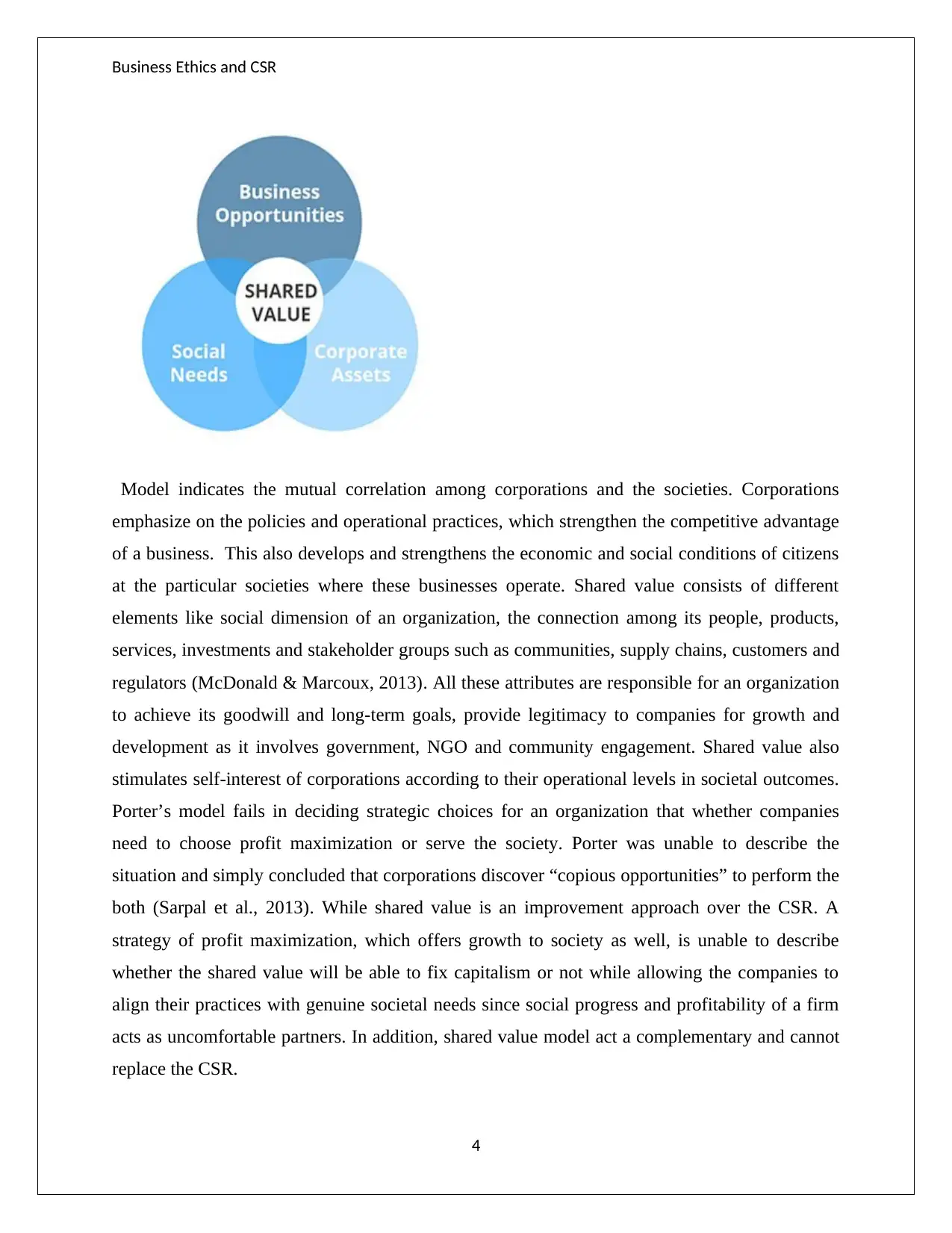
Business Ethics and CSR
Model indicates the mutual correlation among corporations and the societies. Corporations
emphasize on the policies and operational practices, which strengthen the competitive advantage
of a business. This also develops and strengthens the economic and social conditions of citizens
at the particular societies where these businesses operate. Shared value consists of different
elements like social dimension of an organization, the connection among its people, products,
services, investments and stakeholder groups such as communities, supply chains, customers and
regulators (McDonald & Marcoux, 2013). All these attributes are responsible for an organization
to achieve its goodwill and long-term goals, provide legitimacy to companies for growth and
development as it involves government, NGO and community engagement. Shared value also
stimulates self-interest of corporations according to their operational levels in societal outcomes.
Porter’s model fails in deciding strategic choices for an organization that whether companies
need to choose profit maximization or serve the society. Porter was unable to describe the
situation and simply concluded that corporations discover “copious opportunities” to perform the
both (Sarpal et al., 2013). While shared value is an improvement approach over the CSR. A
strategy of profit maximization, which offers growth to society as well, is unable to describe
whether the shared value will be able to fix capitalism or not while allowing the companies to
align their practices with genuine societal needs since social progress and profitability of a firm
acts as uncomfortable partners. In addition, shared value model act a complementary and cannot
replace the CSR.
4
Model indicates the mutual correlation among corporations and the societies. Corporations
emphasize on the policies and operational practices, which strengthen the competitive advantage
of a business. This also develops and strengthens the economic and social conditions of citizens
at the particular societies where these businesses operate. Shared value consists of different
elements like social dimension of an organization, the connection among its people, products,
services, investments and stakeholder groups such as communities, supply chains, customers and
regulators (McDonald & Marcoux, 2013). All these attributes are responsible for an organization
to achieve its goodwill and long-term goals, provide legitimacy to companies for growth and
development as it involves government, NGO and community engagement. Shared value also
stimulates self-interest of corporations according to their operational levels in societal outcomes.
Porter’s model fails in deciding strategic choices for an organization that whether companies
need to choose profit maximization or serve the society. Porter was unable to describe the
situation and simply concluded that corporations discover “copious opportunities” to perform the
both (Sarpal et al., 2013). While shared value is an improvement approach over the CSR. A
strategy of profit maximization, which offers growth to society as well, is unable to describe
whether the shared value will be able to fix capitalism or not while allowing the companies to
align their practices with genuine societal needs since social progress and profitability of a firm
acts as uncomfortable partners. In addition, shared value model act a complementary and cannot
replace the CSR.
4
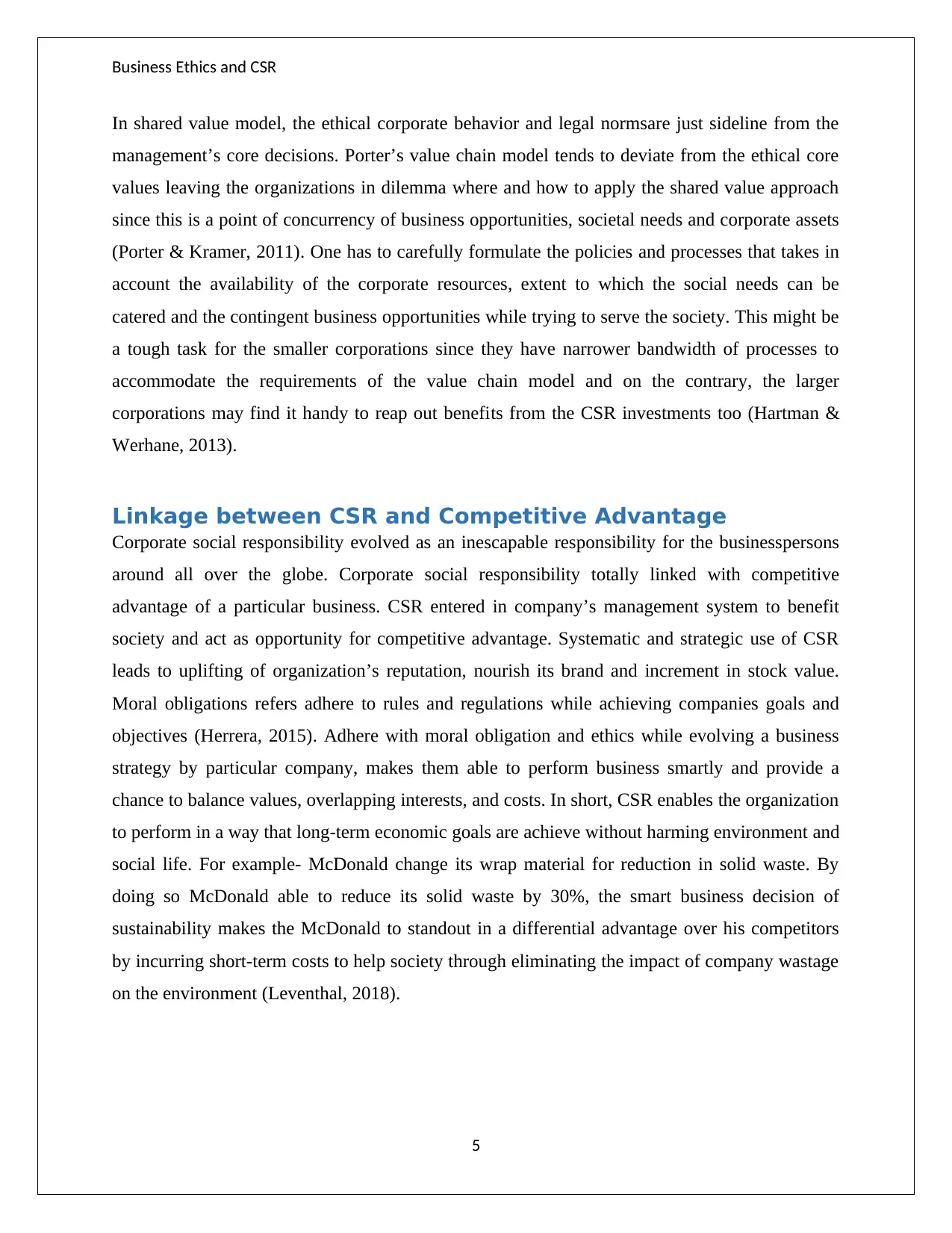
Business Ethics and CSR
In shared value model, the ethical corporate behavior and legal normsare just sideline from the
management’s core decisions. Porter’s value chain model tends to deviate from the ethical core
values leaving the organizations in dilemma where and how to apply the shared value approach
since this is a point of concurrency of business opportunities, societal needs and corporate assets
(Porter & Kramer, 2011). One has to carefully formulate the policies and processes that takes in
account the availability of the corporate resources, extent to which the social needs can be
catered and the contingent business opportunities while trying to serve the society. This might be
a tough task for the smaller corporations since they have narrower bandwidth of processes to
accommodate the requirements of the value chain model and on the contrary, the larger
corporations may find it handy to reap out benefits from the CSR investments too (Hartman &
Werhane, 2013).
Linkage between CSR and Competitive Advantage
Corporate social responsibility evolved as an inescapable responsibility for the businesspersons
around all over the globe. Corporate social responsibility totally linked with competitive
advantage of a particular business. CSR entered in company’s management system to benefit
society and act as opportunity for competitive advantage. Systematic and strategic use of CSR
leads to uplifting of organization’s reputation, nourish its brand and increment in stock value.
Moral obligations refers adhere to rules and regulations while achieving companies goals and
objectives (Herrera, 2015). Adhere with moral obligation and ethics while evolving a business
strategy by particular company, makes them able to perform business smartly and provide a
chance to balance values, overlapping interests, and costs. In short, CSR enables the organization
to perform in a way that long-term economic goals are achieve without harming environment and
social life. For example- McDonald change its wrap material for reduction in solid waste. By
doing so McDonald able to reduce its solid waste by 30%, the smart business decision of
sustainability makes the McDonald to standout in a differential advantage over his competitors
by incurring short-term costs to help society through eliminating the impact of company wastage
on the environment (Leventhal, 2018).
5
In shared value model, the ethical corporate behavior and legal normsare just sideline from the
management’s core decisions. Porter’s value chain model tends to deviate from the ethical core
values leaving the organizations in dilemma where and how to apply the shared value approach
since this is a point of concurrency of business opportunities, societal needs and corporate assets
(Porter & Kramer, 2011). One has to carefully formulate the policies and processes that takes in
account the availability of the corporate resources, extent to which the social needs can be
catered and the contingent business opportunities while trying to serve the society. This might be
a tough task for the smaller corporations since they have narrower bandwidth of processes to
accommodate the requirements of the value chain model and on the contrary, the larger
corporations may find it handy to reap out benefits from the CSR investments too (Hartman &
Werhane, 2013).
Linkage between CSR and Competitive Advantage
Corporate social responsibility evolved as an inescapable responsibility for the businesspersons
around all over the globe. Corporate social responsibility totally linked with competitive
advantage of a particular business. CSR entered in company’s management system to benefit
society and act as opportunity for competitive advantage. Systematic and strategic use of CSR
leads to uplifting of organization’s reputation, nourish its brand and increment in stock value.
Moral obligations refers adhere to rules and regulations while achieving companies goals and
objectives (Herrera, 2015). Adhere with moral obligation and ethics while evolving a business
strategy by particular company, makes them able to perform business smartly and provide a
chance to balance values, overlapping interests, and costs. In short, CSR enables the organization
to perform in a way that long-term economic goals are achieve without harming environment and
social life. For example- McDonald change its wrap material for reduction in solid waste. By
doing so McDonald able to reduce its solid waste by 30%, the smart business decision of
sustainability makes the McDonald to standout in a differential advantage over his competitors
by incurring short-term costs to help society through eliminating the impact of company wastage
on the environment (Leventhal, 2018).
5
⊘ This is a preview!⊘
Do you want full access?
Subscribe today to unlock all pages.

Trusted by 1+ million students worldwide
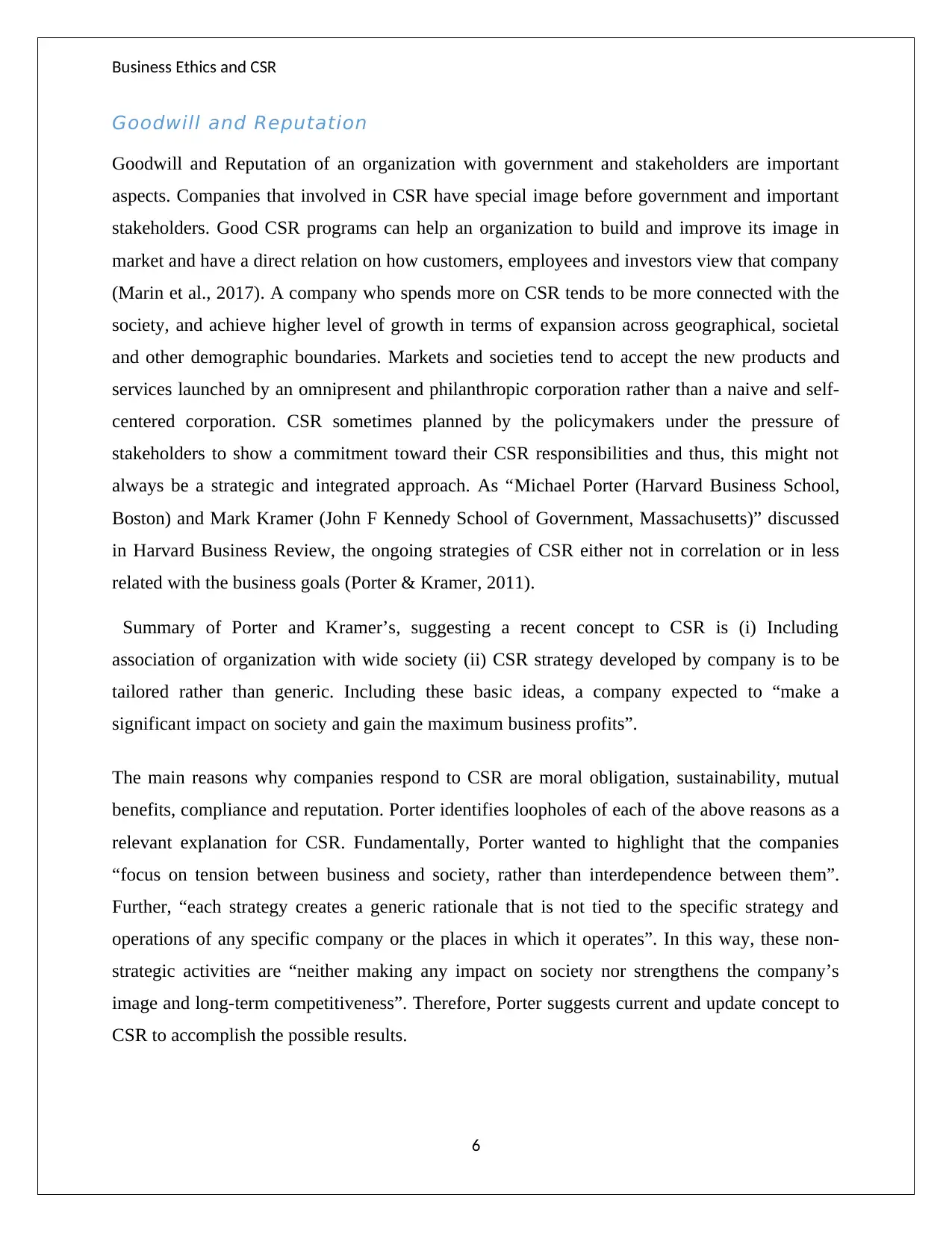
Business Ethics and CSR
Goodwill and Reputation
Goodwill and Reputation of an organization with government and stakeholders are important
aspects. Companies that involved in CSR have special image before government and important
stakeholders. Good CSR programs can help an organization to build and improve its image in
market and have a direct relation on how customers, employees and investors view that company
(Marin et al., 2017). A company who spends more on CSR tends to be more connected with the
society, and achieve higher level of growth in terms of expansion across geographical, societal
and other demographic boundaries. Markets and societies tend to accept the new products and
services launched by an omnipresent and philanthropic corporation rather than a naive and self-
centered corporation. CSR sometimes planned by the policymakers under the pressure of
stakeholders to show a commitment toward their CSR responsibilities and thus, this might not
always be a strategic and integrated approach. As “Michael Porter (Harvard Business School,
Boston) and Mark Kramer (John F Kennedy School of Government, Massachusetts)” discussed
in Harvard Business Review, the ongoing strategies of CSR either not in correlation or in less
related with the business goals (Porter & Kramer, 2011).
Summary of Porter and Kramer’s, suggesting a recent concept to CSR is (i) Including
association of organization with wide society (ii) CSR strategy developed by company is to be
tailored rather than generic. Including these basic ideas, a company expected to “make a
significant impact on society and gain the maximum business profits”.
The main reasons why companies respond to CSR are moral obligation, sustainability, mutual
benefits, compliance and reputation. Porter identifies loopholes of each of the above reasons as a
relevant explanation for CSR. Fundamentally, Porter wanted to highlight that the companies
“focus on tension between business and society, rather than interdependence between them”.
Further, “each strategy creates a generic rationale that is not tied to the specific strategy and
operations of any specific company or the places in which it operates”. In this way, these non-
strategic activities are “neither making any impact on society nor strengthens the company’s
image and long-term competitiveness”. Therefore, Porter suggests current and update concept to
CSR to accomplish the possible results.
6
Goodwill and Reputation
Goodwill and Reputation of an organization with government and stakeholders are important
aspects. Companies that involved in CSR have special image before government and important
stakeholders. Good CSR programs can help an organization to build and improve its image in
market and have a direct relation on how customers, employees and investors view that company
(Marin et al., 2017). A company who spends more on CSR tends to be more connected with the
society, and achieve higher level of growth in terms of expansion across geographical, societal
and other demographic boundaries. Markets and societies tend to accept the new products and
services launched by an omnipresent and philanthropic corporation rather than a naive and self-
centered corporation. CSR sometimes planned by the policymakers under the pressure of
stakeholders to show a commitment toward their CSR responsibilities and thus, this might not
always be a strategic and integrated approach. As “Michael Porter (Harvard Business School,
Boston) and Mark Kramer (John F Kennedy School of Government, Massachusetts)” discussed
in Harvard Business Review, the ongoing strategies of CSR either not in correlation or in less
related with the business goals (Porter & Kramer, 2011).
Summary of Porter and Kramer’s, suggesting a recent concept to CSR is (i) Including
association of organization with wide society (ii) CSR strategy developed by company is to be
tailored rather than generic. Including these basic ideas, a company expected to “make a
significant impact on society and gain the maximum business profits”.
The main reasons why companies respond to CSR are moral obligation, sustainability, mutual
benefits, compliance and reputation. Porter identifies loopholes of each of the above reasons as a
relevant explanation for CSR. Fundamentally, Porter wanted to highlight that the companies
“focus on tension between business and society, rather than interdependence between them”.
Further, “each strategy creates a generic rationale that is not tied to the specific strategy and
operations of any specific company or the places in which it operates”. In this way, these non-
strategic activities are “neither making any impact on society nor strengthens the company’s
image and long-term competitiveness”. Therefore, Porter suggests current and update concept to
CSR to accomplish the possible results.
6
Paraphrase This Document
Need a fresh take? Get an instant paraphrase of this document with our AI Paraphraser
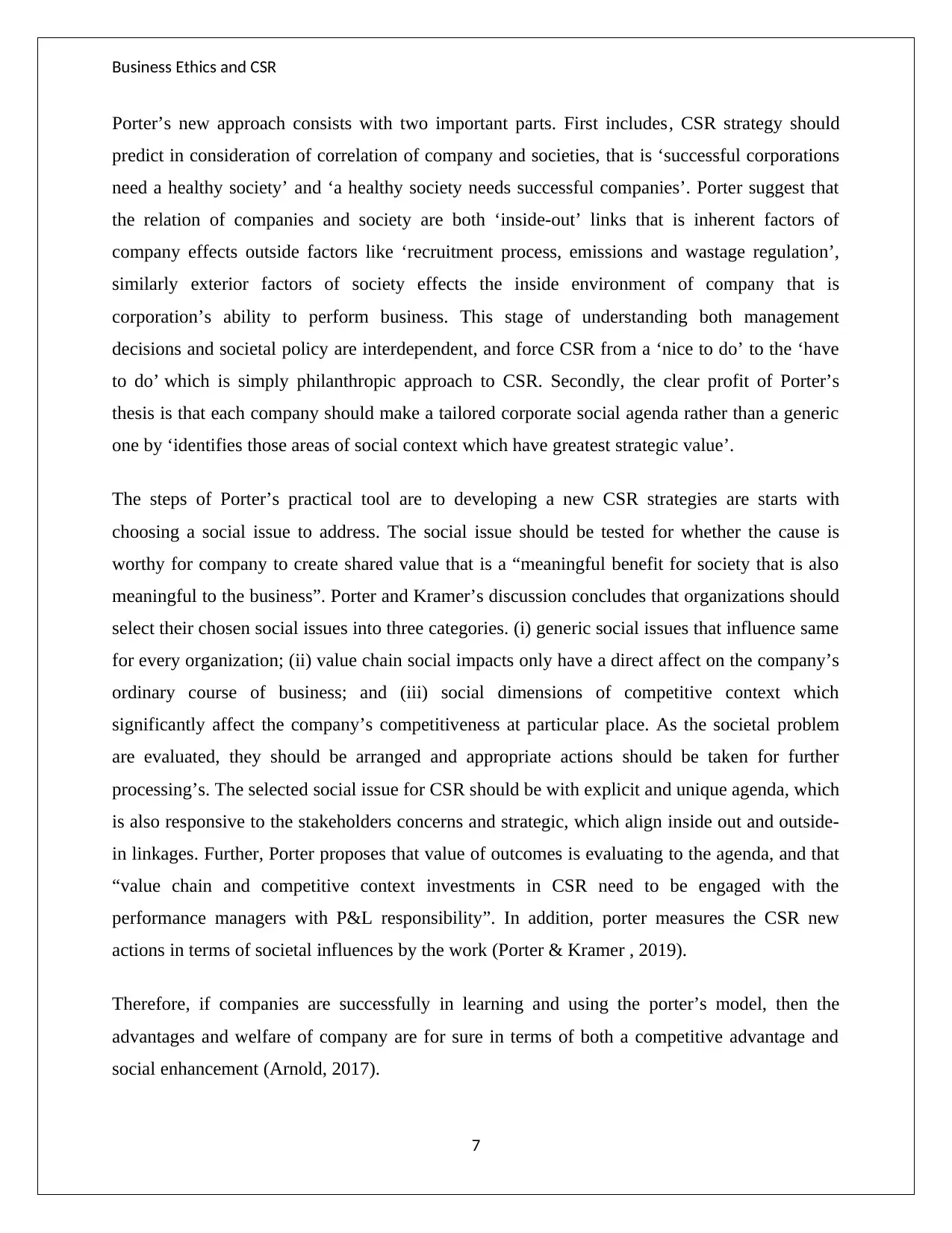
Business Ethics and CSR
Porter’s new approach consists with two important parts. First includes, CSR strategy should
predict in consideration of correlation of company and societies, that is ‘successful corporations
need a healthy society’ and ‘a healthy society needs successful companies’. Porter suggest that
the relation of companies and society are both ‘inside-out’ links that is inherent factors of
company effects outside factors like ‘recruitment process, emissions and wastage regulation’,
similarly exterior factors of society effects the inside environment of company that is
corporation’s ability to perform business. This stage of understanding both management
decisions and societal policy are interdependent, and force CSR from a ‘nice to do’ to the ‘have
to do’ which is simply philanthropic approach to CSR. Secondly, the clear profit of Porter’s
thesis is that each company should make a tailored corporate social agenda rather than a generic
one by ‘identifies those areas of social context which have greatest strategic value’.
The steps of Porter’s practical tool are to developing a new CSR strategies are starts with
choosing a social issue to address. The social issue should be tested for whether the cause is
worthy for company to create shared value that is a “meaningful benefit for society that is also
meaningful to the business”. Porter and Kramer’s discussion concludes that organizations should
select their chosen social issues into three categories. (i) generic social issues that influence same
for every organization; (ii) value chain social impacts only have a direct affect on the company’s
ordinary course of business; and (iii) social dimensions of competitive context which
significantly affect the company’s competitiveness at particular place. As the societal problem
are evaluated, they should be arranged and appropriate actions should be taken for further
processing’s. The selected social issue for CSR should be with explicit and unique agenda, which
is also responsive to the stakeholders concerns and strategic, which align inside out and outside-
in linkages. Further, Porter proposes that value of outcomes is evaluating to the agenda, and that
“value chain and competitive context investments in CSR need to be engaged with the
performance managers with P&L responsibility”. In addition, porter measures the CSR new
actions in terms of societal influences by the work (Porter & Kramer , 2019).
Therefore, if companies are successfully in learning and using the porter’s model, then the
advantages and welfare of company are for sure in terms of both a competitive advantage and
social enhancement (Arnold, 2017).
7
Porter’s new approach consists with two important parts. First includes, CSR strategy should
predict in consideration of correlation of company and societies, that is ‘successful corporations
need a healthy society’ and ‘a healthy society needs successful companies’. Porter suggest that
the relation of companies and society are both ‘inside-out’ links that is inherent factors of
company effects outside factors like ‘recruitment process, emissions and wastage regulation’,
similarly exterior factors of society effects the inside environment of company that is
corporation’s ability to perform business. This stage of understanding both management
decisions and societal policy are interdependent, and force CSR from a ‘nice to do’ to the ‘have
to do’ which is simply philanthropic approach to CSR. Secondly, the clear profit of Porter’s
thesis is that each company should make a tailored corporate social agenda rather than a generic
one by ‘identifies those areas of social context which have greatest strategic value’.
The steps of Porter’s practical tool are to developing a new CSR strategies are starts with
choosing a social issue to address. The social issue should be tested for whether the cause is
worthy for company to create shared value that is a “meaningful benefit for society that is also
meaningful to the business”. Porter and Kramer’s discussion concludes that organizations should
select their chosen social issues into three categories. (i) generic social issues that influence same
for every organization; (ii) value chain social impacts only have a direct affect on the company’s
ordinary course of business; and (iii) social dimensions of competitive context which
significantly affect the company’s competitiveness at particular place. As the societal problem
are evaluated, they should be arranged and appropriate actions should be taken for further
processing’s. The selected social issue for CSR should be with explicit and unique agenda, which
is also responsive to the stakeholders concerns and strategic, which align inside out and outside-
in linkages. Further, Porter proposes that value of outcomes is evaluating to the agenda, and that
“value chain and competitive context investments in CSR need to be engaged with the
performance managers with P&L responsibility”. In addition, porter measures the CSR new
actions in terms of societal influences by the work (Porter & Kramer , 2019).
Therefore, if companies are successfully in learning and using the porter’s model, then the
advantages and welfare of company are for sure in terms of both a competitive advantage and
social enhancement (Arnold, 2017).
7
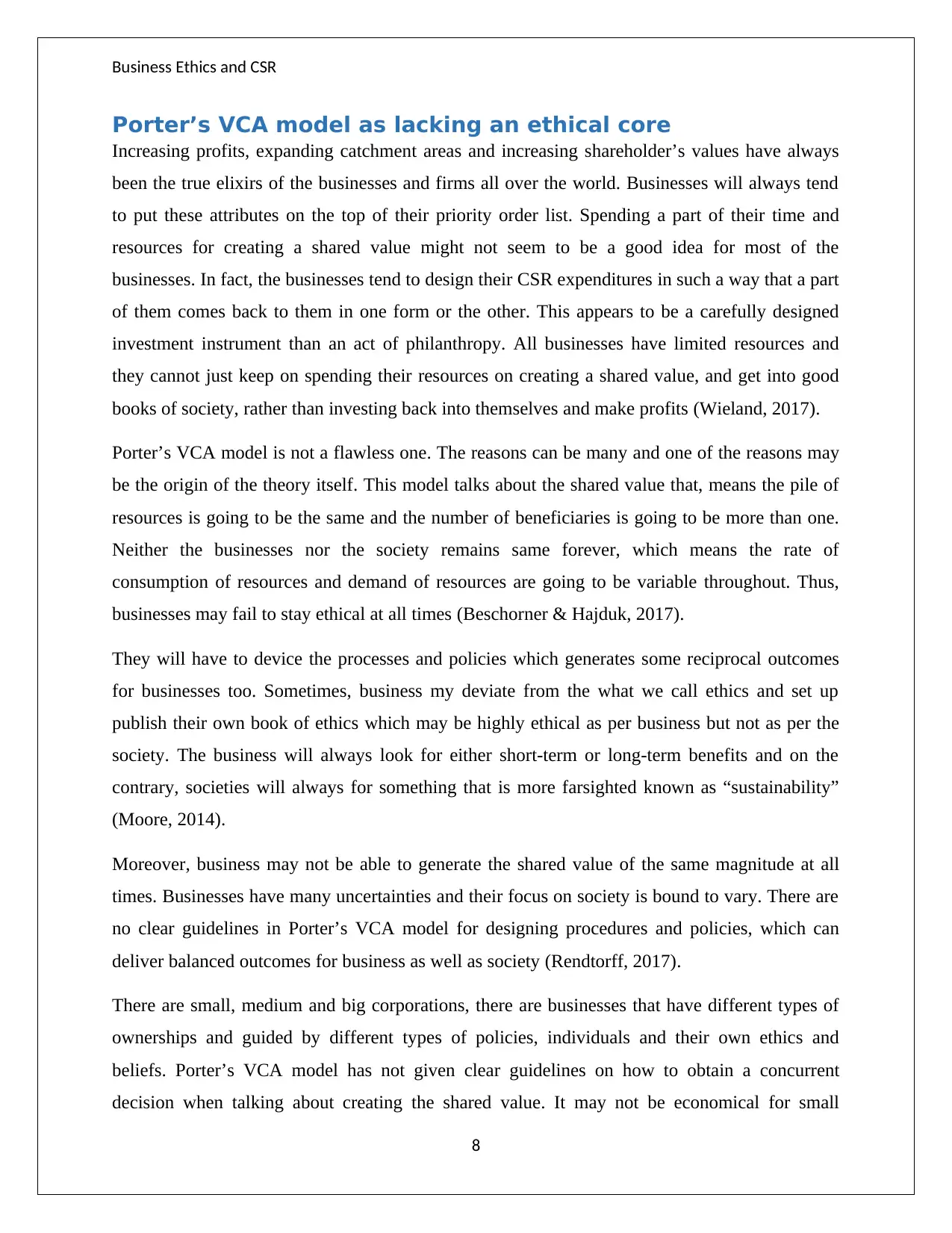
Business Ethics and CSR
Porter’s VCA model as lacking an ethical core
Increasing profits, expanding catchment areas and increasing shareholder’s values have always
been the true elixirs of the businesses and firms all over the world. Businesses will always tend
to put these attributes on the top of their priority order list. Spending a part of their time and
resources for creating a shared value might not seem to be a good idea for most of the
businesses. In fact, the businesses tend to design their CSR expenditures in such a way that a part
of them comes back to them in one form or the other. This appears to be a carefully designed
investment instrument than an act of philanthropy. All businesses have limited resources and
they cannot just keep on spending their resources on creating a shared value, and get into good
books of society, rather than investing back into themselves and make profits (Wieland, 2017).
Porter’s VCA model is not a flawless one. The reasons can be many and one of the reasons may
be the origin of the theory itself. This model talks about the shared value that, means the pile of
resources is going to be the same and the number of beneficiaries is going to be more than one.
Neither the businesses nor the society remains same forever, which means the rate of
consumption of resources and demand of resources are going to be variable throughout. Thus,
businesses may fail to stay ethical at all times (Beschorner & Hajduk, 2017).
They will have to device the processes and policies which generates some reciprocal outcomes
for businesses too. Sometimes, business my deviate from the what we call ethics and set up
publish their own book of ethics which may be highly ethical as per business but not as per the
society. The business will always look for either short-term or long-term benefits and on the
contrary, societies will always for something that is more farsighted known as “sustainability”
(Moore, 2014).
Moreover, business may not be able to generate the shared value of the same magnitude at all
times. Businesses have many uncertainties and their focus on society is bound to vary. There are
no clear guidelines in Porter’s VCA model for designing procedures and policies, which can
deliver balanced outcomes for business as well as society (Rendtorff, 2017).
There are small, medium and big corporations, there are businesses that have different types of
ownerships and guided by different types of policies, individuals and their own ethics and
beliefs. Porter’s VCA model has not given clear guidelines on how to obtain a concurrent
decision when talking about creating the shared value. It may not be economical for small
8
Porter’s VCA model as lacking an ethical core
Increasing profits, expanding catchment areas and increasing shareholder’s values have always
been the true elixirs of the businesses and firms all over the world. Businesses will always tend
to put these attributes on the top of their priority order list. Spending a part of their time and
resources for creating a shared value might not seem to be a good idea for most of the
businesses. In fact, the businesses tend to design their CSR expenditures in such a way that a part
of them comes back to them in one form or the other. This appears to be a carefully designed
investment instrument than an act of philanthropy. All businesses have limited resources and
they cannot just keep on spending their resources on creating a shared value, and get into good
books of society, rather than investing back into themselves and make profits (Wieland, 2017).
Porter’s VCA model is not a flawless one. The reasons can be many and one of the reasons may
be the origin of the theory itself. This model talks about the shared value that, means the pile of
resources is going to be the same and the number of beneficiaries is going to be more than one.
Neither the businesses nor the society remains same forever, which means the rate of
consumption of resources and demand of resources are going to be variable throughout. Thus,
businesses may fail to stay ethical at all times (Beschorner & Hajduk, 2017).
They will have to device the processes and policies which generates some reciprocal outcomes
for businesses too. Sometimes, business my deviate from the what we call ethics and set up
publish their own book of ethics which may be highly ethical as per business but not as per the
society. The business will always look for either short-term or long-term benefits and on the
contrary, societies will always for something that is more farsighted known as “sustainability”
(Moore, 2014).
Moreover, business may not be able to generate the shared value of the same magnitude at all
times. Businesses have many uncertainties and their focus on society is bound to vary. There are
no clear guidelines in Porter’s VCA model for designing procedures and policies, which can
deliver balanced outcomes for business as well as society (Rendtorff, 2017).
There are small, medium and big corporations, there are businesses that have different types of
ownerships and guided by different types of policies, individuals and their own ethics and
beliefs. Porter’s VCA model has not given clear guidelines on how to obtain a concurrent
decision when talking about creating the shared value. It may not be economical for small
8
⊘ This is a preview!⊘
Do you want full access?
Subscribe today to unlock all pages.

Trusted by 1+ million students worldwide
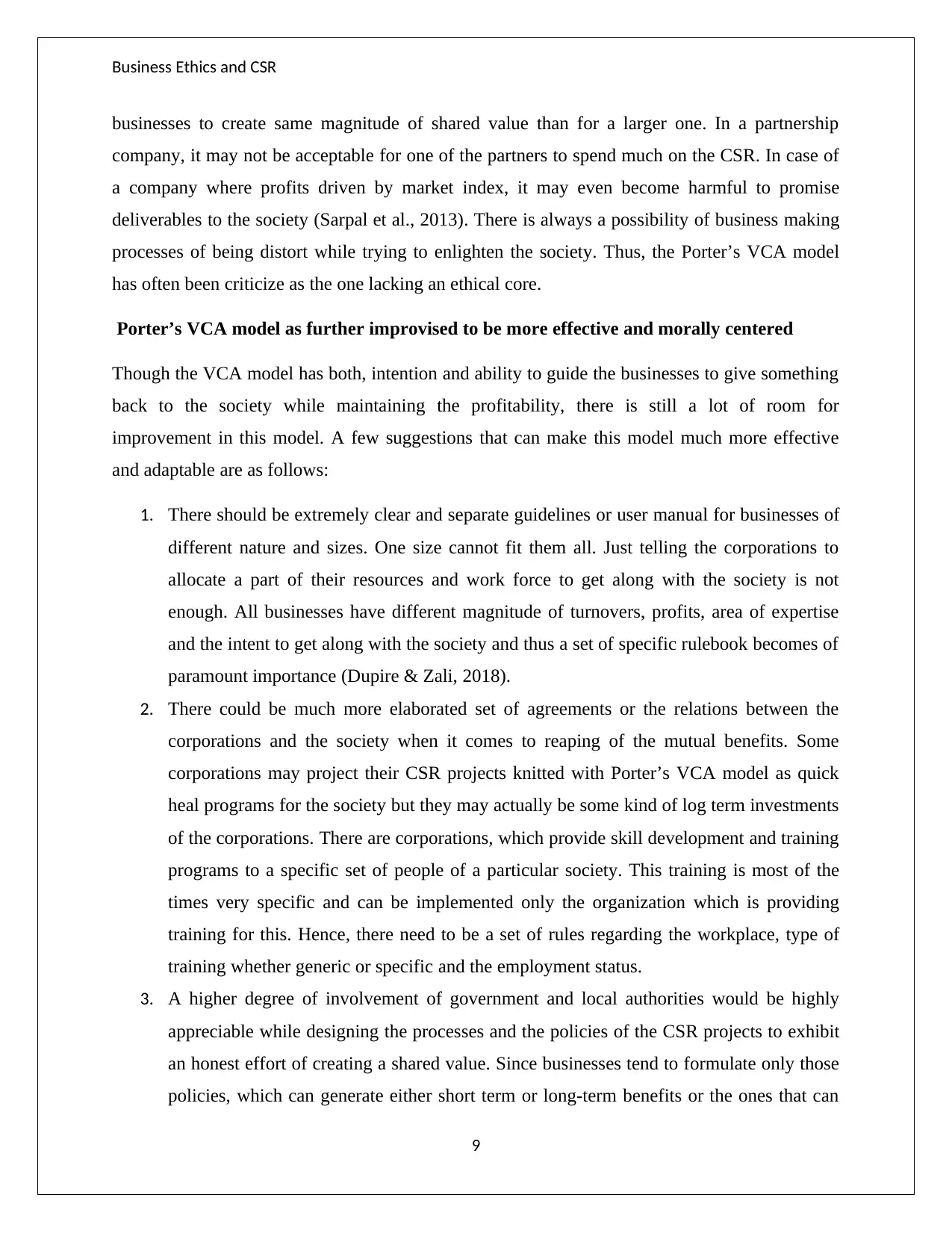
Business Ethics and CSR
businesses to create same magnitude of shared value than for a larger one. In a partnership
company, it may not be acceptable for one of the partners to spend much on the CSR. In case of
a company where profits driven by market index, it may even become harmful to promise
deliverables to the society (Sarpal et al., 2013). There is always a possibility of business making
processes of being distort while trying to enlighten the society. Thus, the Porter’s VCA model
has often been criticize as the one lacking an ethical core.
Porter’s VCA model as further improvised to be more effective and morally centered
Though the VCA model has both, intention and ability to guide the businesses to give something
back to the society while maintaining the profitability, there is still a lot of room for
improvement in this model. A few suggestions that can make this model much more effective
and adaptable are as follows:
1. There should be extremely clear and separate guidelines or user manual for businesses of
different nature and sizes. One size cannot fit them all. Just telling the corporations to
allocate a part of their resources and work force to get along with the society is not
enough. All businesses have different magnitude of turnovers, profits, area of expertise
and the intent to get along with the society and thus a set of specific rulebook becomes of
paramount importance (Dupire & Zali, 2018).
2. There could be much more elaborated set of agreements or the relations between the
corporations and the society when it comes to reaping of the mutual benefits. Some
corporations may project their CSR projects knitted with Porter’s VCA model as quick
heal programs for the society but they may actually be some kind of log term investments
of the corporations. There are corporations, which provide skill development and training
programs to a specific set of people of a particular society. This training is most of the
times very specific and can be implemented only the organization which is providing
training for this. Hence, there need to be a set of rules regarding the workplace, type of
training whether generic or specific and the employment status.
3. A higher degree of involvement of government and local authorities would be highly
appreciable while designing the processes and the policies of the CSR projects to exhibit
an honest effort of creating a shared value. Since businesses tend to formulate only those
policies, which can generate either short term or long-term benefits or the ones that can
9
businesses to create same magnitude of shared value than for a larger one. In a partnership
company, it may not be acceptable for one of the partners to spend much on the CSR. In case of
a company where profits driven by market index, it may even become harmful to promise
deliverables to the society (Sarpal et al., 2013). There is always a possibility of business making
processes of being distort while trying to enlighten the society. Thus, the Porter’s VCA model
has often been criticize as the one lacking an ethical core.
Porter’s VCA model as further improvised to be more effective and morally centered
Though the VCA model has both, intention and ability to guide the businesses to give something
back to the society while maintaining the profitability, there is still a lot of room for
improvement in this model. A few suggestions that can make this model much more effective
and adaptable are as follows:
1. There should be extremely clear and separate guidelines or user manual for businesses of
different nature and sizes. One size cannot fit them all. Just telling the corporations to
allocate a part of their resources and work force to get along with the society is not
enough. All businesses have different magnitude of turnovers, profits, area of expertise
and the intent to get along with the society and thus a set of specific rulebook becomes of
paramount importance (Dupire & Zali, 2018).
2. There could be much more elaborated set of agreements or the relations between the
corporations and the society when it comes to reaping of the mutual benefits. Some
corporations may project their CSR projects knitted with Porter’s VCA model as quick
heal programs for the society but they may actually be some kind of log term investments
of the corporations. There are corporations, which provide skill development and training
programs to a specific set of people of a particular society. This training is most of the
times very specific and can be implemented only the organization which is providing
training for this. Hence, there need to be a set of rules regarding the workplace, type of
training whether generic or specific and the employment status.
3. A higher degree of involvement of government and local authorities would be highly
appreciable while designing the processes and the policies of the CSR projects to exhibit
an honest effort of creating a shared value. Since businesses tend to formulate only those
policies, which can generate either short term or long-term benefits or the ones that can
9
Paraphrase This Document
Need a fresh take? Get an instant paraphrase of this document with our AI Paraphraser
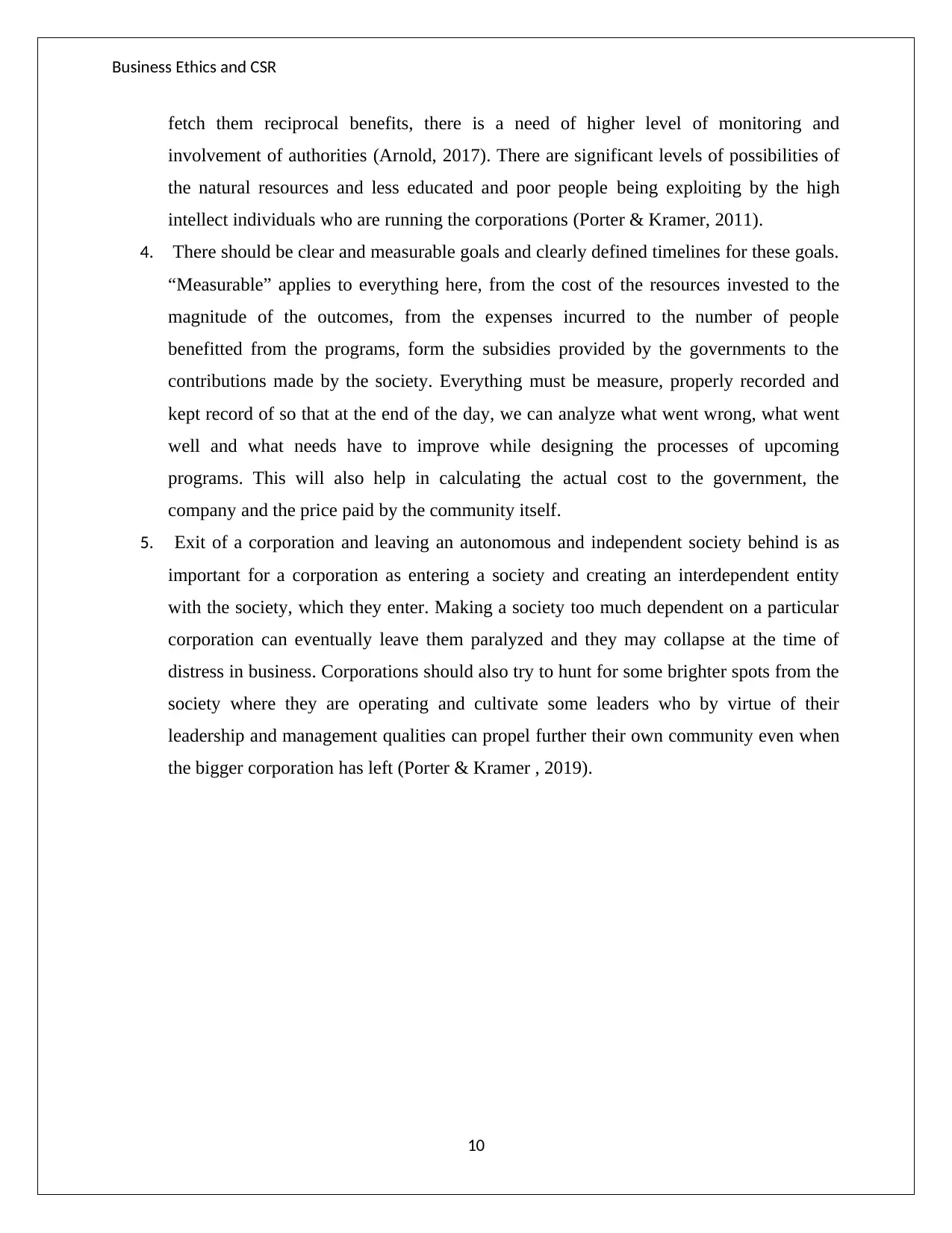
Business Ethics and CSR
fetch them reciprocal benefits, there is a need of higher level of monitoring and
involvement of authorities (Arnold, 2017). There are significant levels of possibilities of
the natural resources and less educated and poor people being exploiting by the high
intellect individuals who are running the corporations (Porter & Kramer, 2011).
4. There should be clear and measurable goals and clearly defined timelines for these goals.
“Measurable” applies to everything here, from the cost of the resources invested to the
magnitude of the outcomes, from the expenses incurred to the number of people
benefitted from the programs, form the subsidies provided by the governments to the
contributions made by the society. Everything must be measure, properly recorded and
kept record of so that at the end of the day, we can analyze what went wrong, what went
well and what needs have to improve while designing the processes of upcoming
programs. This will also help in calculating the actual cost to the government, the
company and the price paid by the community itself.
5. Exit of a corporation and leaving an autonomous and independent society behind is as
important for a corporation as entering a society and creating an interdependent entity
with the society, which they enter. Making a society too much dependent on a particular
corporation can eventually leave them paralyzed and they may collapse at the time of
distress in business. Corporations should also try to hunt for some brighter spots from the
society where they are operating and cultivate some leaders who by virtue of their
leadership and management qualities can propel further their own community even when
the bigger corporation has left (Porter & Kramer , 2019).
10
fetch them reciprocal benefits, there is a need of higher level of monitoring and
involvement of authorities (Arnold, 2017). There are significant levels of possibilities of
the natural resources and less educated and poor people being exploiting by the high
intellect individuals who are running the corporations (Porter & Kramer, 2011).
4. There should be clear and measurable goals and clearly defined timelines for these goals.
“Measurable” applies to everything here, from the cost of the resources invested to the
magnitude of the outcomes, from the expenses incurred to the number of people
benefitted from the programs, form the subsidies provided by the governments to the
contributions made by the society. Everything must be measure, properly recorded and
kept record of so that at the end of the day, we can analyze what went wrong, what went
well and what needs have to improve while designing the processes of upcoming
programs. This will also help in calculating the actual cost to the government, the
company and the price paid by the community itself.
5. Exit of a corporation and leaving an autonomous and independent society behind is as
important for a corporation as entering a society and creating an interdependent entity
with the society, which they enter. Making a society too much dependent on a particular
corporation can eventually leave them paralyzed and they may collapse at the time of
distress in business. Corporations should also try to hunt for some brighter spots from the
society where they are operating and cultivate some leaders who by virtue of their
leadership and management qualities can propel further their own community even when
the bigger corporation has left (Porter & Kramer , 2019).
10
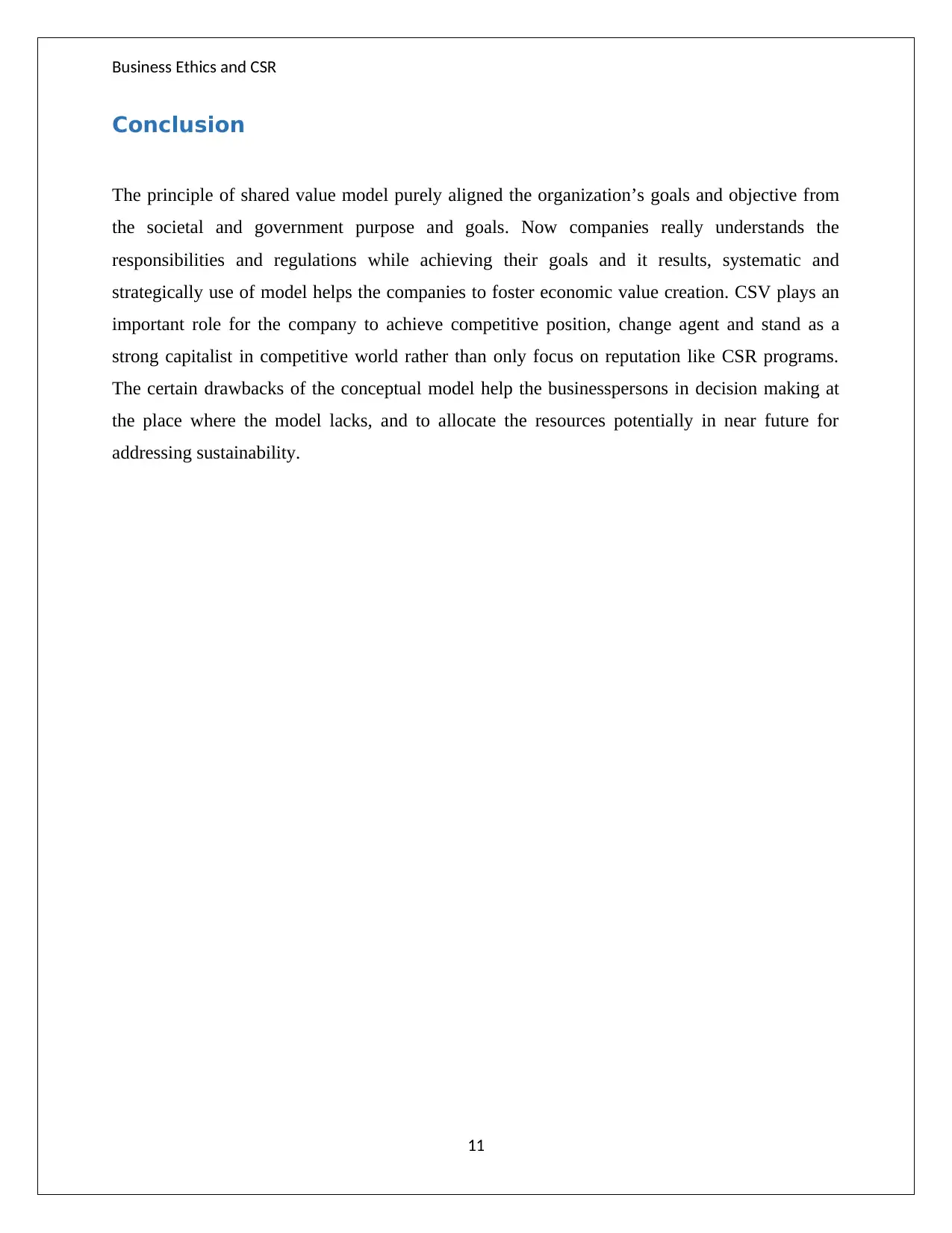
Business Ethics and CSR
Conclusion
The principle of shared value model purely aligned the organization’s goals and objective from
the societal and government purpose and goals. Now companies really understands the
responsibilities and regulations while achieving their goals and it results, systematic and
strategically use of model helps the companies to foster economic value creation. CSV plays an
important role for the company to achieve competitive position, change agent and stand as a
strong capitalist in competitive world rather than only focus on reputation like CSR programs.
The certain drawbacks of the conceptual model help the businesspersons in decision making at
the place where the model lacks, and to allocate the resources potentially in near future for
addressing sustainability.
11
Conclusion
The principle of shared value model purely aligned the organization’s goals and objective from
the societal and government purpose and goals. Now companies really understands the
responsibilities and regulations while achieving their goals and it results, systematic and
strategically use of model helps the companies to foster economic value creation. CSV plays an
important role for the company to achieve competitive position, change agent and stand as a
strong capitalist in competitive world rather than only focus on reputation like CSR programs.
The certain drawbacks of the conceptual model help the businesspersons in decision making at
the place where the model lacks, and to allocate the resources potentially in near future for
addressing sustainability.
11
⊘ This is a preview!⊘
Do you want full access?
Subscribe today to unlock all pages.

Trusted by 1+ million students worldwide
1 out of 14
Related Documents
Your All-in-One AI-Powered Toolkit for Academic Success.
+13062052269
info@desklib.com
Available 24*7 on WhatsApp / Email
![[object Object]](/_next/static/media/star-bottom.7253800d.svg)
Unlock your academic potential
Copyright © 2020–2025 A2Z Services. All Rights Reserved. Developed and managed by ZUCOL.





